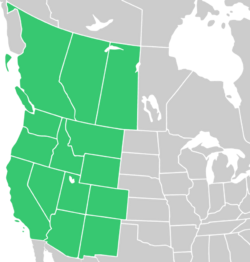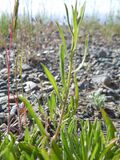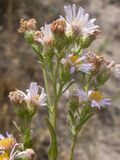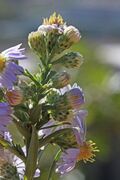Biology:Symphyotrichum eatonii
| Symphyotrichum eatonii | |
|---|---|

| |
| Scientific classification | |
| Kingdom: | Plantae |
| Clade: | Tracheophytes |
| Clade: | Angiosperms |
| Clade: | Eudicots |
| Clade: | Asterids |
| Order: | Asterales |
| Family: | Asteraceae |
| Tribe: | Astereae |
| Subtribe: | Symphyotrichinae |
| Genus: | Symphyotrichum |
| Subgenus: | Symphyotrichum subg. Symphyotrichum |
| Section: | Symphyotrichum sect. Occidentales |
| Species: | S. eatonii
|
| Binomial name | |
| Symphyotrichum eatonii (A.Gray) G.L.Nesom[2]
| |

| |
| Native distribution[2] | |
| Synonyms[2] | |
| |
Symphyotrichum eatonii (formerly Aster eatonii) is a species of aster known by the common name Eaton's aster.[3] It is native to much of western North America from British Columbia to Saskatchewan, the Sierra Nevada in California , the Rocky Mountains region, to Arizona and New Mexico, where it grows in many habitats, especially wet areas such as meadows and near ditches.[4]
Description
Symphyotrichum eatonii is a perennial herb growing 40–100 centimeters (1 foot 4 inches–3 feet 3 inches) from a short rhizome. The thin leaves are up to 20 centimeters (8 inches) long, lance-shaped, and pointed at the tips. Some of the leaves and the upper parts of the stem are hairy.[4]
The inflorescence holds several flower heads containing many white to pink ray florets around a center of yellow disk florets. The fruit is a hairy cypsela that resembles an achene.[4]
Taxonomy
Symphyotrichum eatonii is classified in the subgenus Symphyotrichum, section Occidentales.[4] (As of June 2021) Catalogue of Life, Flora of North America, and Jepson eFlora accepted this species as Symphyotrichum bracteolatum,[5][4][6] while POWO, NatureServe, and Canadian botanist John C. Semple circumscribed to S. eatonii.[2][1][7]
Citations
- ↑ 1.0 1.1 NatureServe 2021.
- ↑ 2.0 2.1 2.2 2.3 POWO 2021.
- ↑ USDA 2015.
- ↑ 4.0 4.1 4.2 4.3 4.4 Brouillet et al. 2020.
- ↑ Hassler 2021.
- ↑ Allen 2012.
- ↑ Semple 2021.
References
- Template:Cite Jepson eFlora
- "Symphyotrichum bracteolatum". Point Arena, California: Flora of North America Association. 6 November 2020. http://floranorthamerica.org/Symphyotrichum_bracteolatum.
- Hassler, M. (17 March 2021). "Symphyotrichum bracteolatum (Nutt.) G. L. Nesom – World Plants: Synonymic Checklists of the Vascular Plants of the World". in Roskov, Y.; Ower, G.; Orrell, T. et al. (in en). Species 2000 & ITIS Catalogue of Life, 10 June 2021. Leiden, Netherlands: Naturalis Biodiversity Center. https://www.catalogueoflife.org/data/taxon/7NMHT. Retrieved 21 June 2021.
- "Symphyotrichum eatonii - Eaton's Aster". Arlington, Virginia: NatureServe. 4 June 2021. https://explorer.natureserve.org/Taxon/ELEMENT_GLOBAL.2.139599/Symphyotrichum_eatonii.
- POWO (2021). "Symphyotrichum bracteolatum (Nutt.) G.L.Nesom" (in en). Royal Botanic Gardens, Kew. http://www.plantsoftheworldonline.org/taxon/1001047-1.
- "Symphyotrichum eatonii". Ontario: University of Waterloo. 17 May 2021. https://uwaterloo.ca/astereae-lab/research/asters/symphyotrichum/symphyotrichum-subsect-occidentales/symphyotrichum-eatonii.
- "Symphyotrichum eatonii". Natural Resources Conservation Service PLANTS Database. USDA. 2015. https://plants.usda.gov/core/profile?symbol=SYEA2.
External links
Wikidata ☰ {{{from}}} entry
 |






